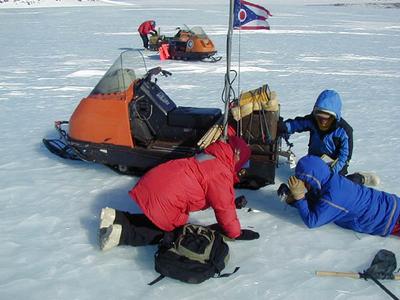27 December, 2002
Collecting Procedures
Today was the kind of day I expected in Antarctica. It started out cold,
windy, and overcast and remained that way well into the afternoon. I
really am making good use of the hand and foot warmers Carl gave everyone
for Christmas. We went to Jacob's Nunatak and did systematic searching all
morning.
The searching turned up a few meteorites, but less than we had hoped. So,
after finishing the blue ice on the western side of Schuttaine Moraine at
Jacob's Nunatak (named after John Schutt) we did our first walking
systematic search. Overall, we're getting pretty good on the snowmobiles
at doing systematic searches, but we drive better than we walk. We were
crossing each others paths and walking nearly random paths looking at
rocks. We chose to do this because the rocks were clustered too tightly to
really see all of them from a snowmobile. This search yielded two more
meteorites. We actually found enough meteorites today to break the 300
meteorite mark for the season so far.
How we collect the meteorites is actually something we take very
carefully. We have three meteorite collecting kits with us so that there
is usually someone close by who is packing a kit. The meteorite is first
given a number with an aluminum tag and photographed with that number on a
manual counter. The dimensions and fusion crust percentage are recorded
and the meteorite can then be moved by a pair of sterile tongs. We do our
best not to touch the meteorite or let it touch anything but the tongs, but
accidents do occur, so we make a note of it in the record book. We take
this care so that if anything anomalous is found later, they can be sure
that it wasn't caused by us.
In 1996, it was reported that nanofossils of bacteria and other chemical
signatures of life were found in a Martian meteorite found by the 1984
ANSMET team. One of the biggest questions asked by skeptics was whether
that contamination happened after the meteorite landed in Antarctica. We
have all witnessed meteorites in liquid water at temperatures well below
freezing. The rocks beneath the ice re-radiate heat and a thin layer of
ice can create a mini greenhouse effect allowing liquid water to exist. We
want to make sure that if anything like that is ever found again, that we
had nothing to do with any contamination.
After the meteorite is collected, it is dropped into a sterile plastic bag
and sealed with freezer tape. The meteorites are brought back to camp and
put in a storage unit called an isopod in which they will be shipped to the
Johnson Space Center for further analysis. (See October journal entries
for descriptions of what happens there).
After we finished searching the Jacob's Nunatak area, we went up to an area
will we be searching shortly. Jamie took us to a spot that overlooked our
camping area and had an amazing view of the mountains and glaciers. We
spotted a black object about a quarter of a mile away on a precarious icy
cliff. We thought it might be a large meteorite. Jamie volunteered to
check it out and strapped on a pair of crampons and headed up to the
object. We watched intently through binoculars and telephoto lenses as
Jamie approached the object. With a grand motion, Jamie picked up the
object and revealed that it was just a large plastic trash bag. He brought
it back for inspection and none of us could figure where it came from. But
this had to be the most effort given to recovering a trash bag.
The winds have picked up tonight, but hopefully they will die down and we
can begin more blue ice systematic searching tomorrow. Otherwise, we will
go back to the moraines.

Linda collecting, Jamie taking photos, and Nancy recording data as a meteorite is carefully collected.
Contact the TEA in the field at
.
If you cannot connect through your browser, copy the
TEA's e-mail address in the "To:" line of
your favorite e-mail package.
|
